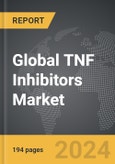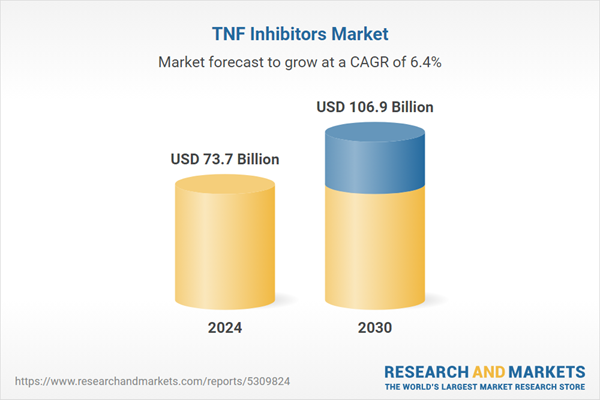The global market for TNF Inhibitors was valued at US$73.7 Billion in 2024 and is projected to reach US$106.9 Billion by 2030, growing at a CAGR of 6.4% from 2024 to 2030. This comprehensive report provides an in-depth analysis of market trends, drivers, and forecasts, helping you make informed business decisions. The report includes the most recent global tariff developments and how they impact the TNF Inhibitors market.
Segments: Application (Rheumatoid Arthritis, Psoriasis, Crohn’s Disease, Psoriatic Arthritis, Ulcerative Colitis, Other Applications).
Geographic Regions/Countries: World; United States; Canada; Japan; China; Europe (France; Germany; Italy; United Kingdom; Spain; Russia; and Rest of Europe); Asia-Pacific (Australia; India; South Korea; and Rest of Asia-Pacific); Latin America (Argentina; Brazil; Mexico; and Rest of Latin America); Middle East (Iran; Israel; Saudi Arabia; United Arab Emirates; and Rest of Middle East); and Africa.
The analysts continuously track trade developments worldwide, drawing insights from leading global economists and over 200 industry and policy institutions, including think tanks, trade organizations, and national economic advisory bodies. This intelligence is integrated into forecasting models to provide timely, data-driven analysis of emerging risks and opportunities.
Global TNF Inhibitors Market - Key Trends & Drivers Summarized
What Are TNF Inhibitors and Why Are They Important?
TNF inhibitors, or Tumor Necrosis Factor inhibitors, are a class of medications used primarily to reduce inflammation by blocking the activity of TNF, a substance in the body that causes inflammation in autoimmune diseases. These inhibitors are commonly prescribed for conditions such as rheumatoid arthritis, psoriatic arthritis, ankylosing spondylitis, and inflammatory bowel disease. The discovery and development of TNF inhibitors have revolutionized the treatment landscape for these chronic and often debilitating conditions, offering patients improved quality of life and disease management. With their ability to target specific pathways in the immune system, TNF inhibitors represent a significant advancement in biologic therapy.How Do TNF Inhibitors Work in Clinical Settings?
TNF inhibitors function by binding to TNF molecules and preventing them from interacting with their receptors on the surface of cells. This interaction is crucial in the inflammatory process, and by inhibiting it, these drugs reduce the overall inflammatory response. Clinically, TNF inhibitors have shown substantial efficacy in reducing symptoms, slowing disease progression, and improving physical function in patients with autoimmune diseases. They are administered through injections or infusions, and their use requires careful monitoring due to potential side effects such as increased risk of infections and certain cancers. Despite these risks, their benefits in controlling severe inflammation and preventing long-term damage have made them a cornerstone in the management of autoimmune conditions.What Are the Challenges and Opportunities in TNF Inhibitors Development?
The development and use of TNF inhibitors come with several challenges and opportunities. One major challenge is the cost, as these biologics are expensive to produce and can be a financial burden on patients and healthcare systems. Additionally, there is a continuous need for research to improve their safety profiles and minimize adverse effects. On the opportunity side, advancements in biotechnology and personalized medicine are paving the way for more targeted and effective treatments. Biosimilars, which are similar but not identical to original biologic drugs, are entering the market, promising to reduce costs and increase accessibility. Furthermore, ongoing research into combination therapies and new indications for TNF inhibitors could expand their use and efficacy.What Is Driving the Growth in the TNF Inhibitors Market?
The growth in the TNF inhibitors market is driven by several factors. Firstly, the increasing prevalence of autoimmune diseases globally has created a higher demand for effective treatment options. Secondly, advancements in biotechnology and the development of biosimilars are making these treatments more accessible and affordable. Thirdly, there is a growing awareness among patients and healthcare providers about the benefits of early and aggressive treatment of autoimmune diseases, which is boosting the adoption of TNF inhibitors. Additionally, favorable government policies and healthcare reimbursement systems in various regions are supporting market growth. Finally, continuous innovation and research in the field are leading to the development of new and improved TNF inhibitors, further propelling the market forward. These combined factors are expected to sustain the robust growth of the TNF inhibitors market in the coming years.Report Scope
The report analyzes the TNF Inhibitors market, presented in terms of units. The analysis covers the key segments and geographic regions outlined below.Segments: Application (Rheumatoid Arthritis, Psoriasis, Crohn’s Disease, Psoriatic Arthritis, Ulcerative Colitis, Other Applications).
Geographic Regions/Countries: World; United States; Canada; Japan; China; Europe (France; Germany; Italy; United Kingdom; Spain; Russia; and Rest of Europe); Asia-Pacific (Australia; India; South Korea; and Rest of Asia-Pacific); Latin America (Argentina; Brazil; Mexico; and Rest of Latin America); Middle East (Iran; Israel; Saudi Arabia; United Arab Emirates; and Rest of Middle East); and Africa.
Key Insights:
- Market Growth: Understand the significant growth trajectory of the Rheumatoid Arthritis segment, which is expected to reach US$22.7 Billion by 2030 with a CAGR of a 8.3%. The Psoriasis segment is also set to grow at 6.5% CAGR over the analysis period.
- Regional Analysis: Gain insights into the U.S. market, valued at $19.5 Billion in 2024, and China, forecasted to grow at an impressive 10.6% CAGR to reach $24.7 Billion by 2030. Discover growth trends in other key regions, including Japan, Canada, Germany, and the Asia-Pacific.
Why You Should Buy This Report:
- Detailed Market Analysis: Access a thorough analysis of the Global TNF Inhibitors Market, covering all major geographic regions and market segments.
- Competitive Insights: Get an overview of the competitive landscape, including the market presence of major players across different geographies.
- Future Trends and Drivers: Understand the key trends and drivers shaping the future of the Global TNF Inhibitors Market.
- Actionable Insights: Benefit from actionable insights that can help you identify new revenue opportunities and make strategic business decisions.
Key Questions Answered:
- How is the Global TNF Inhibitors Market expected to evolve by 2030?
- What are the main drivers and restraints affecting the market?
- Which market segments will grow the most over the forecast period?
- How will market shares for different regions and segments change by 2030?
- Who are the leading players in the market, and what are their prospects?
Report Features:
- Comprehensive Market Data: Independent analysis of annual sales and market forecasts in US$ Million from 2024 to 2030.
- In-Depth Regional Analysis: Detailed insights into key markets, including the U.S., China, Japan, Canada, Europe, Asia-Pacific, Latin America, Middle East, and Africa.
- Company Profiles: Coverage of players such as AbbVie Inc., Amgen Inc., Biocad Biopharmaceutical Co., Boehringer Ingelheim Pharmaceuticals, Inc., EPIRUS Biopharmaceuticals, Inc. and more.
- Complimentary Updates: Receive free report updates for one year to keep you informed of the latest market developments.
Some of the 41 companies featured in this TNF Inhibitors market report include:
- AbbVie Inc.
- Amgen Inc.
- Biocad Biopharmaceutical Co.
- Boehringer Ingelheim Pharmaceuticals, Inc.
- EPIRUS Biopharmaceuticals, Inc.
- Innovent Biologics, Inc.
- Janssen Biotech, Inc.
- Johnson & Johnson Services, Inc.
- Merck & co., Inc.
- Novartis International AG
- Pfizer, Inc.
- Shanghai Henlius Biotech, Inc.
- UCB S.A.
Tariff Impact Analysis: Key Insights for 2025
Global tariff negotiations across 180+ countries are reshaping supply chains, costs, and competitiveness. This report reflects the latest developments as of April 2025 and incorporates forward-looking insights into the market outlook.The analysts continuously track trade developments worldwide, drawing insights from leading global economists and over 200 industry and policy institutions, including think tanks, trade organizations, and national economic advisory bodies. This intelligence is integrated into forecasting models to provide timely, data-driven analysis of emerging risks and opportunities.
What’s Included in This Edition:
- Tariff-adjusted market forecasts by region and segment
- Analysis of cost and supply chain implications by sourcing and trade exposure
- Strategic insights into geographic shifts
Buyers receive a free July 2025 update with:
- Finalized tariff impacts and new trade agreement effects
- Updated projections reflecting global sourcing and cost shifts
- Expanded country-specific coverage across the industry
Table of Contents
I. METHODOLOGYII. EXECUTIVE SUMMARY2. FOCUS ON SELECT PLAYERSIII. MARKET ANALYSISSOUTH KOREAREST OF ASIA-PACIFICARGENTINABRAZILMEXICOREST OF LATIN AMERICAIRANISRAELSAUDI ARABIAUNITED ARAB EMIRATESREST OF MIDDLE EASTIV. COMPETITION
1. MARKET OVERVIEW
3. MARKET TRENDS & DRIVERS
4. GLOBAL MARKET PERSPECTIVE
UNITED STATES
CANADA
JAPAN
CHINA
EUROPE
FRANCE
GERMANY
ITALY
UNITED KINGDOM
SPAIN
RUSSIA
REST OF EUROPE
ASIA-PACIFIC
AUSTRALIA
INDIA
LATIN AMERICA
MIDDLE EAST
AFRICA
Companies Mentioned (Partial List)
A selection of companies mentioned in this report includes, but is not limited to:
- AbbVie Inc.
- Amgen Inc.
- Biocad Biopharmaceutical Co.
- Boehringer Ingelheim Pharmaceuticals, Inc.
- EPIRUS Biopharmaceuticals, Inc.
- Innovent Biologics, Inc.
- Janssen Biotech, Inc.
- Johnson & Johnson Services, Inc.
- Merck & co., Inc.
- Novartis International AG
- Pfizer, Inc.
- Shanghai Henlius Biotech, Inc.
- UCB S.A.
Table Information
| Report Attribute | Details |
|---|---|
| No. of Pages | 191 |
| Published | April 2025 |
| Forecast Period | 2024 - 2030 |
| Estimated Market Value ( USD | $ 73.7 Billion |
| Forecasted Market Value ( USD | $ 106.9 Billion |
| Compound Annual Growth Rate | 6.4% |
| Regions Covered | Global |









